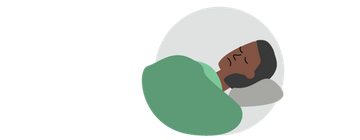Practicing Home-Based Care and Isolation for COVID-19
Home-based care is care that family, friends or a community member give to someone who is sick at home 🏠. This care is provided based on the guidance of trained health workers. People who have COVID-19, need to isolate (stay separate from others) at home. This prevents the transmission of COVID-19 in the household. Providing home-based care for people with mild COVID-19 helps health workers focus on COVID-19 patients that need their full attention in a health facility. Watch this video to learn more about home-based care.
If you cannot view the above video, you can instead download it.
Who is Eligible for Home-Based Care
Health workers play an important role in advising patients and their caregivers on how to safely practice home-based care and isolation. There are 3 criteria for patients to qualify for home-based care:
- Not at high risk for severe COVID-19;
- have a suitable caregiver;
- appropriate living conditions.
People at high risk have underlying health conditions and are 60+. Patients with mild COVID-19 symptoms who live with others that are at high risk for severe COVID-19 or are over 60 years must not be cared for at home. Poeple at high risk for severe COVID-19, including those 60 years and older, have a high fever and one other COVID-19 symptoms or get severe symptoms should be referred to a health facility. 🏥
A person with mild COVID-19 should pick one caregiver that has no underlying health conditions and is under 60 years old. The caregiver should not leave home while giving care and stay isolated for 14 days after the person they are caring for no longer shows any symptoms. If a person with COVID-19 lives alone, a neighbor or friend can drop off supplies. This person should stay 6ft (2m) away and wear proper PPE to limit exposure.
Ideally, the home of the patient who is being cared for must have running water🚰 and a private space for the patient to isolate. People who live in congregate settings such as camps, informal settlements or long-term care facilities cannot get home-based care and must be cared for at a local isolation center or special isolation spaces. Know where these spaces are in your community to you can refer patients who cannot receive care at home.
If your patient is eligible for home-based care, they should monitor their symptoms at home. You can advise caregivers on how to safely support the patient at home. You can still support your patients while they are at home by conducting virtual visits using telehealth tools, such as basic mobile messaging and video services.
Example questions to ask to determine if medical referral is necessary include:
- are you having shortness of breath when doing tasks that they would normally not have trouble doing including sitting,
- is walking a short distance harder than before when they were not sick, and
- if they have any new chest pain or pressure.
How to Practice Home-Based Care and Isolation
For those who are practicing home-based care, show them how to use the self-check toolkit 📋. The self-check toolkit guides patients so they can monitor their symptoms and know when to seek care at a health facility if they experience severe symptoms of COVID-19 . Severe symptoms are shown in this picture.

Bluish lips or face

Chest pain or pressure in the chest

Extreme difficulty breathing or shortness of breath

Disorientation or confusion

Inability to wake or stay awake

Slurred speech
Show caregivers how to safely support the patient and monitor their symptoms using a daily log. Caregivers must seek care if the patient's symptoms get worse.
Ending Isolation

Patients with symptoms must isolate for at least 10 days after symptoms begin and for 3 days after their symptoms end. Patients without symptoms must isolate for 10 days after a positive COVID-19 test.
Average Rating: ☆ ☆ ☆ ☆ ☆ (0 reviews)


